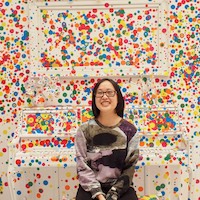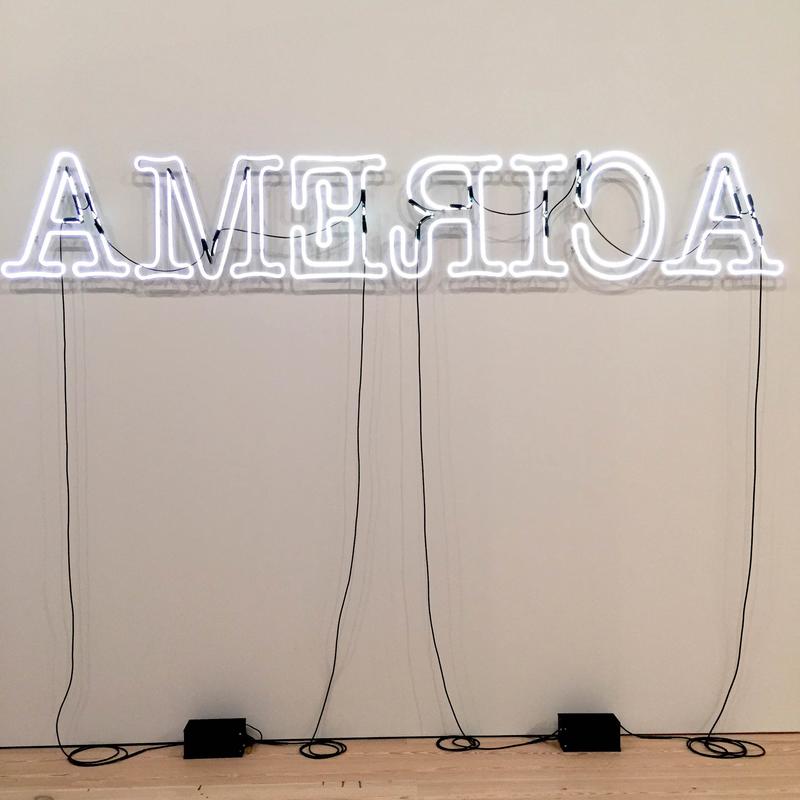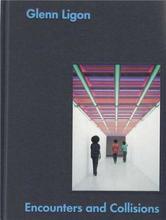More about Rückenfigur
- All
- Info
- Shop

Contributor
Glenn Ligon’s neon sculpture, Rückenfigur, points out a glaring racial divide between people’s perceptions of America.
Rückenfigur, translated directly from German, means “back figure,” a style of painting popularized by Transcendentalist paintings and screenshots from dramatic movie scenes. You’ve probably seen that famous one by Caspar David Friedrich, with the man in black standing over a foggy valley, his back to the audience, that frequently finds its way into the chapter title pages of high school textbooks. What Friedrich has to do with physics is anyone’s guess, but there’s no denying that the pose is quite epic.
In this piece, though, the Rückenfigur sheds its inspirational intentions for a work that leaves a less-than-appetizing aftertaste. Ligon, ever the fan of exposing words for their insurmountable ties to identity, replaces the man in black with a supersized, flip-flopped version of “America”—his version of America as an African-American. He attributes inspiration for the piece to the opening line of Charles Dickens’ A Tale of Two Cities: “It was the best of times, it was the worst of times.”
LACMA hangs the piece on the wall, but its brother at the Whitney lies flat on the ground. They made their debut in 2011, the same year President Obama was asked to release his birth certificate to prove his citizenship. For a country that claims to embrace people of every ethnicity, America often turns its back on the people that call it their home; even the president cannot escape its secretly discriminating eye. Ligon’s Rückenfigur reveals realities about the country that America’s flag—including Jasper Johns’ Cold-War-inspired rendition—fail to show.
Ligon said he thought it was interesting that even when viewed backward, the word “America” still looks like “America.” He stated, “I realized that if you turn the letters around, it makes a very strange word. It's still the word 'America.’ The word faces you and turns away from you at the same time." Metaphorically and literally, though, some things are clearly different. Ligon’s experiences show up on the neon tubing as black paint marks, while the flipped but appropriately ordered letters help nudge viewers towards its main message.
At first glance, “America” appears perfectly normal. After a second lookover, though, something seems off. Ligon grants you the rare opportunity to become the man looking over the valley with his back to the camera—except the valley is an entire country and unsettling things are happening behind the fog.
Sources
- "Glenn Ligon Reframes History In The Art Of 'America'." NPR. May 08, 2011. http://www.npr.org/2011/05/08/136022514/glenn-ligon-reframes-history-in….
- Pollack, Maika. "American Like Me: Glenn Ligon at the Whitney." Observer. May 10, 2011. Accessed August 23, 2017. http://observer.com/2011/05/american-like-me-glenn-ligon-at-the-whitney/.
- Wetzler, Rachel. "The Limits of Text and Image: Glenn Ligon at the Whitney." Hyperallergic. May 11, 2011. Accessed August 23, 2017. https://hyperallergic.com/23800/glenn-ligon-whitney/.













